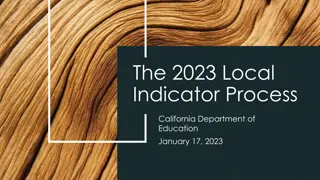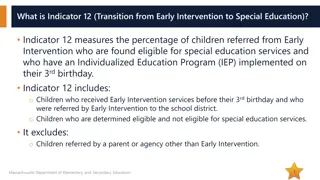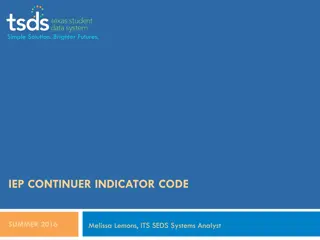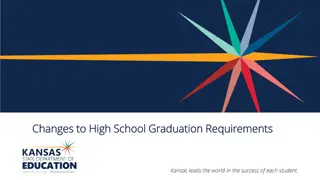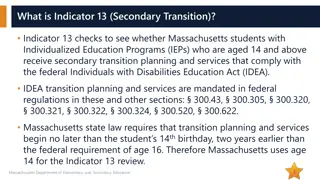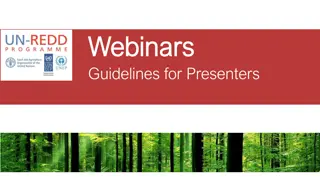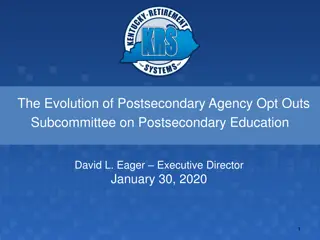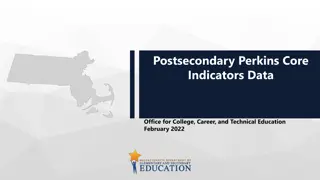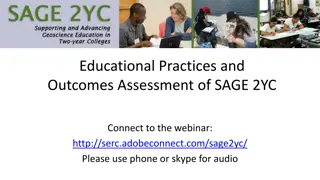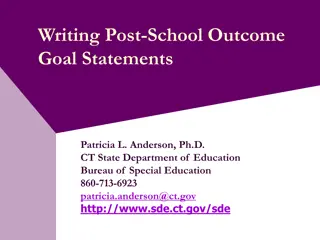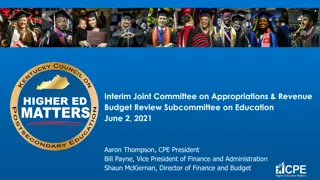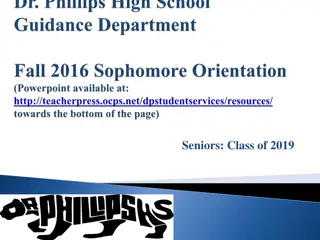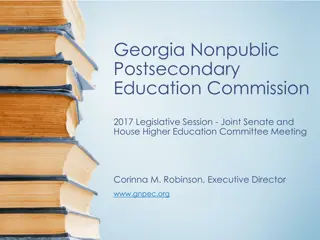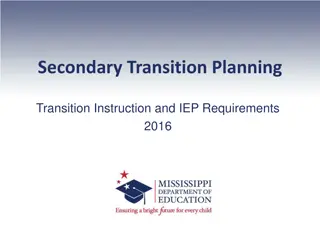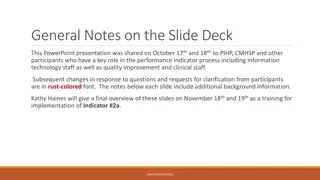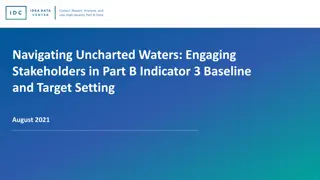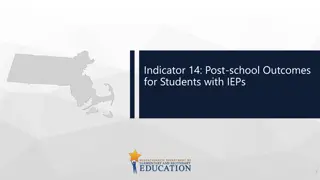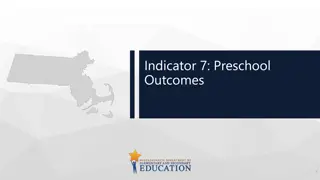Understanding Postsecondary Outcomes - Indicator B-14 Webinar Overview
The Indicator B-14 webinar provides information on postsecondary outcomes for youth with IEPs, focusing on indicators like higher education enrollment and competitive employment within one year of leaving high school. The webinar covers survey procedures, response rates, and results from the Michigan Department of Education's Office of Special Education. Definitions of Indicator 14 and key terms like higher education and competitive employment are explained in detail during the presentation.
Download Presentation

Please find below an Image/Link to download the presentation.
The content on the website is provided AS IS for your information and personal use only. It may not be sold, licensed, or shared on other websites without obtaining consent from the author. Download presentation by click this link. If you encounter any issues during the download, it is possible that the publisher has removed the file from their server.
E N D
Presentation Transcript
Welcome! The Understand Indicator B-14 (Postsecondary Outcomes) Webinar will begin in a few moments. The webinar will be recorded and posted on the Catamaran Technical Assistance Website under Past Events (https://training.catamaran.partners/past-events/). The PowerPoint presentation materials will also be posted and available for download on the Catamaran Technical Assistance Website under Past Events (https://training.catamaran.partners/past-events/). To communicate with the presenters during the webinar, use the Chat feature in the webinar player. Closed captioning is available for this webinar. To select this option, choose the closed caption icon in the webinar player. MDE Office of Special Education
Part B SPP Indicator 14 Postsecondary Outcomes Post-School Survey Procedures and Results March 23, 2021 Michigan Department of Education (MDE) Office of Special Education (OSE)
Overview 1. About State Performance Plan (SPP) Indicator 14 2. Survey Process 3. Survey Response Rate 4. Survey Results MDE Office of Special Education 3
About SPP Indicator 14 MDE Office of Special Education 4
Indicator 14 Defined Defined by the Office of Special Education Programs (OSEP) as Percent of youth who are no longer in secondary school, had individualized educational programs (IEPs) in effect at the time they left school, and, within one year of leaving high school, were: A. Enrolled in higher education. B. Enrolled in higher education or competitively employed. C. Enrolled in higher education or in some other postsecondary education or training program; or competitively employed or in some other employment. MDE Office of Special Education 5
Indicator 14 Higher Education Defined Higher education defined: At any time in the year since leaving high school. Enrolled for at least one complete term on a full- or part-time basis in: o Community college (two-year program); or o College/university (four- or more year program). MDE Office of Special Education 6
Indicator 14 Competitive Employment Defined As a result of the Workforce Innovation and Opportunity Act (WIOA) and the reauthorization of the Rehabilitation Act, there was a shift in the definition of competitive employment to competitive integrated employment. Competitive Employment Competitive Integrated Employment (Starting FFY 2018) (FFY 2009 FFY 2017) Work at or above minimum wage Work for at least 20 hours per week Work at or above minimum wage Work for at least 90 cumulative days Work for at least 20 hours per week Work receiving a customary pay rate Work receiving benefits Work for at least 90 cumulative days Work having the opportunity for advancement Work in a setting interacting with people without disabilities MDE Office of Special Education 7
Indicator 14 OSEP Reporting Categories Calculation of Indicator 14 outcomes, using OSEP reporting categories. Category 1 = number in higher education. Category 2 = number competitively employed. Category 3 = number in some other postsecondary education or training (but not in higher education or competitively employed). Category 4 = number in some other employment (but not enrolled in higher education, some other postsecondary education or training program, or competitive employed. Number of other/not engaged (states are not required to report this number). Measure A = category 1 divided by the total respondents Measure B = Category plus category 2 divided by the total respondents Measure C = Category 1 plus category 2 plus category 3 plus category 4 divided by total respondents. MDE Office of Special Education 8
Indicator 14 Annual Performance Report (APR) The results for the post-secondary outcome data are reported in the Annual Public Report (APR) and due to OSEP by February 1 each year. More information can also be found on the MDE website: https://www.michigan.gov/mde/0,4615,7-140- 6598_88189_88207---,00.html Michigan s FFY2018 APR can be found here: https://www.michigan.gov/documents/mde/APR_Glance_5716 53_7.pdf Michigan is working on resetting the Indicator 14 targets for FFY2020 to FFY2025. MDE Office of Special Education 9
Measuring Postsecondary Outcomes Have former students attained competitive employment and/or enrolled in a postsecondary education and/or training program? How can we find out? Measure postsecondary outcomes BY Surveying former students THEN Look at their responses MDE Office of Special Education 10
Survey Questions: Higher Education Higher Education or Training Program High school completion document or certificate (Adult Basic Education, GED). Short-term education or employment training program (Job Corps, Michigan Works, Summer Employment Program, etc.). 1. At any time since leaving high school, have you ever attended any school, job training, or education program? Vocational Technical School less than 2-year degree program. Community or Technical College to obtain a 2 year degree. 2. Did you complete an entire term? College or University to earn a 4 or more year degree. 3. Describe the kind of school or job training program you attended? (Please fill in all that apply) On a mission, in the Peace Corps, etc. Enrolled in studies while incarcerated in jail or prison. Other (please specify): MDE Office of Special Education 11
Survey Questions Continued: Competitive Employment Competitive Employment 4. At any time since leaving high school, have you ever worked? 5. Since leaving high school, have you worked at any time for a total of 3 months (about 90 days)? 6. Did you work on average 20 or more hours per week (or about half time of a 40-hour week)? 7. Were you paid at least minimum wage? 8. Were you paid the same as other people who work in a similar job with the same skills, experience, and training? 9. Did you receive benefits comparable to those of employees without disabilities in a similar position (for example, health insurance)? 10. When doing your job, did you interact with other employees without disabilities? 11. In this job, were you eligible for (or could you get) a pay raise or promotion? 12. Where was your most recent job? (Choices are offered to respondent) MDE Office of Special Education 12
Survey Process MDE Office of Special Education 13
Overview of Survey Process Activities Survey Adaption/Human Investigation Committee (HIC) review Time Frame January Database from MDE February and March MDE announcement to ISDs/Transition Coordinators Late Feb to early March Phase 1 data collection to former students who exited high school during Fall 2019 through Spring 2020 (pre-survey notification, mail and online survey, reminder postcard, and follow up phone interviews) Phase 2 data collection former students who exited high school at the end of 2019-2020 school year (same procedures) April to August June to August Support to former students and parents April to August Targeted ISD follow up July and August Data entry, cleaning, analysis and report writing September to December MDE Office of Special Education 14
Survey Sampling Sampling plan approved by MDE: Data are collected in 3 cohorts. List of former students provided by MDE. All ISDs are represented in each cohort: Sampling frame: o All youth (grade 9 and up to age 21) who had an IEP and who left high school in the previous academic year. Two-stage sampling plan: o Stage one (cluster sample): roughly 1/3 of all member districts in each ISD. o Stage two: select the entire universe within each member district. MDE Office of Special Education 15
Example of Survey Sampling by ISD Cool ISD (N=15 member districts) Co ho rt 3 (N =5 dis tri cts ) 2 0 1 7 - 1 8 L e a v e r s o S u r v e y c o m p l e t e d i n S p r i n g / S u m m e o MDE Office of Special Education 16
MDE Announcement to ISDs MDE sends email announcement to Intermediate School District (ISD) Special Education Directors approximately one month prior to survey administration. Includes information on Indicator 8 Parent Survey and Indicator 14 Post- School Survey. Announcement includes: o Notification of Wayne State University s (WSU s) involvement in the survey process. o Survey timeline. o Information on appropriate school involvement. o Sample letters for the pre-survey notification. o Sample letters for the survey packet. o Sample phone script. o List of member district cohorts. MDE Office of Special Education 17
Updating Contact Information Transition Coordinators (TCs) volunteer to: 1. Update contact information on former students: WSU also uses: 1. Phone service companies that append phone numbers based on addresses. a. WSU sends list of former students to volunteering TCs, which in turn gets updated with any new contact info they may have [phone numbers (home, cellular, alternative), alternative addresses, and emails]. 2. Online directory look-up. 2. Send copies of exit interview forms to WSU. MDE Office of Special Education 18
Pre-Survey Notification Former students over the age of 18 are sent a packet containing: Former students under the age of 18 or with cognitive development delay are sent a packet addressed to a parent, guardian, or caregiver: 1. Letter of introduction from MDE explaining purpose of survey. 1. Packet contains same items as above. 2. Letter of introduction from WSU with opt-out information. 2. Parents, guardians, and caregivers have two weeks to opt former student out of the study. oOffers Arabic- and Spanish-speaking students or parents an opportunity to call a toll-free number to opt-out of, or to complete the survey. 3. Parents, guardians, and caregivers may complete the survey if preferred. 3. Information sheet required by HIC (Human Investigation Committee human subjects protection). MDE Office of Special Education 19
Survey Administration Multi-mode approach Mail Telephone Online/Web-based Pre-survey notification. Will call ALL non- respondents with phone numbers. An online survey link is provided in the survey packet with a unique un-identifying code. Survey packet. Reminder postcard. Re-mails (per updated addresses, requests by phone, targeted follow-up). MDE Office of Special Education 20
Survey Administration (continued) All former students who do not opt-out or are not removed from the study by a parent, guardian, or caregiver will receive a survey via postal Mail, containing: Cover letter from WSU: Computer Assisted Telephone Interviewing (CATI) Arabic- and Spanish-speaking interviewers available to conduct interviews. During follow-up, former students are contacted via CATI to complete the survey over the telephone. Will attempt to contact a former student up to eight times (during different times and days, including evenings and weekends). Arabic- and Spanish-speaking interviewers available to conduct interviews. Includes a user ID and password, and instructions on how to complete the Online survey. o Offers Arabic- and Spanish-speaking students a toll-free number to complete the survey over the phone. Survey form. Postage-paid return envelope. o MDE Office of Special Education 21
Survey Response Rate MDE Office of Special Education 22
Response Rate Across Years FFY 2014 FFY 2015 FFY 2016 FFY 2017 FFY 2018 FFY 2019 Cohort 2 3 1 2 3 1 School Year 13/14 14/15 15/16 16/17 17/18 18/19 Survey Year (Spring/Summer) Number Surveyed (valid contact*) Number Responded 2015 2016 2017 2018 2019 2020 3,015 3,636 3,294 3,231 3,437 3,582 707 785 737 771 794 808 Response Rate 23.45% 21.59% 22.37% 23.86% 23.10% 22.56% * Records with invalid contact information (both phone and address) were excluded in the calculation of the response rate. MDE Office of Special Education 23
Response Rate by Mode Around 60% of surveys are completed by phone. Mail Completes FFY 2014 FFY 2015 FFY 2016 FFY 2017 FFY 2018 FFY 2019 n 254 280 280 275 235 254 % 35.9% 35.7% 38.0% 35.6% 29.6% 31.4% Phone Completes FFY 2014 FFY 2015 FFY 2016 FFY 2017 FFY 2018 FFY 2019 n 445 497 456 487 537 532 % 62.9% 63.3% 61.9% 63.2% 67.6% 65.9% Online Completes FFY 2014 FFY 2015 FFY 2016 FFY 2017 FFY 2018 FFY 2019 n 8 8 1 9 22 22 % 1.1% 1.0% 0.1% 1.2% 2.8% 2.7% MDE Office of Special Education 24
Increasing Response Rate 1. Updated contact lists, from volunteering Teacher Consultants: o WSU sends lists of former students to be surveyed o Send exit interview forms to WSU 4. Email announcement to ISDs, etc 5. Pre-survey notification 6. Multi-mode survey administration 7. Spanish- and Arabic- interviewers 2. Phone look-up via multiple resources 8. Reminder postcards 3. MDE database that includes student information 9. Re-mails MDE Office of Special Education 25
Potential Strategies for Increasing Response Rate Locating Youth After Exiting Improve Exit Survey Keep local data systems current Inform students and family that they may be contacted Attempt to locate students via the Department of Motor Vehicles Member district maintains and updates student information bi-annually Google students Go where students are; locate them at their favorite places Member district rechecks fall enrollments for students who may have returned Pay students to keep in touch Have students develop a resume, providing personal and professional references Send written correspondences or correspondences through email Improve the quality of exit interviews (ask about future plans) Send written correspondences to family, friends and personal references Send written correspondences prior to exiting Contact the Office of Vocational Rehabilitation Consider using Aristotle s Nationwide Voter File Source: NPSO (2007). Collecting post-school outcome data: Strategies for increasing response rates. Retrieved from: https://files.eric.ed.gov/fulltext/ED575738.pdf MDE Office of Special Education 26
Survey Results MDE Office of Special Education 27
Indicator 14 Federal Reporting Categories FFY2019 Within 1 year of leaving high school Calculation of Indicator 14 results using OSEP reporting categories with FFY 2019 data. Category 1 = 219 in higher education. Category 2 = 110 competitively employed. Category 3 = 93 in some other postsecondary education or training (but not in higher education or competitively employed). Category 4 = 209 in some other employment (but not enrolled in higher education, some other postsecondary education or training program, or competitive employed. 177 other/not engaged (states are not required to report this number). Total respondents = 808 Measure A = 27.10% (219 divided by 808) Measure B = 40.72% (219 plus 110 divided by 808) Measure C = 78.09% (219 plus 110 plus 93 plus 209 divided by 808. MDE Office of Special Education 28
Indicator 14 Outcomes by Measure FFY2019 Measurement Category: within one year of leaving high school Number (n=808) Percent A. Enrolled in higher education. 219 27.10% B. Enrolled in higher education or competitively employed. 329 40.72% C. Enrolled in higher education or in some other postsecondary education or training program; or competitively employed or in some other employment. 631 78.09% Do not fall into any of above measurement categories 177 21.91% MDE Office of Special Education 29
Indicator 14 Outcomes by Measure FFY2019 (cont) Over one-quarter (27.10%) of former students were enrolled in postsecondary education or training. Measure A o Higher education enrollment among high school graduates in Michigan in the general education population was 59.8% for 2019.* Combined, more than two-fifths (40.72%) were enrolled in a postsecondary education or training program or competitively employed. Measure B Overall, the majority of former students (78.09%) reported positive outcomes one year after leaving high school. They were enrolled in higher education or in some other postsecondary education, or competitively employed or in some other employment. Measure C *MI school data https://www.mischooldata.org/college-enrollment-by-hs-1/ MDE Office of Special Education 30
Indicator 14 Results Across Years Meas ure A Resul ts Measu re B Result s Measu re C Result s F F Y 100% 90% F F Y 1 4 78.09% 34.79 % 77.09 % 77.43% 65.35 % 77.09% 76.93% 76.82% 80% 75.19% 70% Drop due to the change in the definition of competitive employment. F F Y 1 5 32.36 % 63.31 % 76.82 % 60% 65.35% 64.85% 63.31% 62.96% 50% F F Y 1 6 32.56 % 62.96 % 76.93 % 40% 42.82% 40.72% 34.79% 30% 32.56% 32.36% F F Y 1 7 29.18% 28.21% 27.10% 29.18 % 64.85 % 77.43 % 20% 10% F F Y 1 8 28.21 % 42.82 % 75.19 % 0% FFY14 FFY15 FFY16 FFY17 FFY18 FFY19 F F Y 1 9 MDE Office of Special Education 27.10 % 40.72 % 78.09 % Measure A Measure B Measure C 31
Measure A Results Across Years: Michigan vs National Median Percentage Measur e A Nationa l Median Percent age Measu re A Result s MI Measur e A Targets - MI FF Y FF Y1 4 34.79 % 26.10 % 33.00% FF Y1 5 32.36 % 27.40 % 33.20% FF Y1 6 32.56 % 26.30 % 33.40% FF Y1 7 29.18 % 26.40 % 33.60% FF Y1 8 28.21 % 25.20 % 33.90% FF Y1 9 Not availabl e 27.10 % 33.90% https://sites.ed.gov/idea/files/PartB-IndicatorAnalysis-FFY2018.pdf MDE Office of Special Education 32
Measure B Results Across Years: Michigan vs National Median Percentage Measu re B Natio nal Media n Perce ntage Meas ure B Resu lts MI Measu re B Target s - MI FF Y FF Y1 4 65.3 5% 61.20 % 59.50 % FF Y1 5 63.3 1% 63.00 % 60.00 % FF Y1 6 62.9 6% 62.00 % 60.50 % FF Y1 7 64.8 5% 62.70 % 61.00 % FF Y1 8 42.8 2% 62.00 % 61.50 % FF Y1 9 Not availa ble 40.7 2% 61.50 % https://sites.ed.gov/idea/files/PartB-IndicatorAnalysis-FFY2018.pdf MDE Office of Special Education 33
Measure C Results Across Years: Michigan vs National Median Percentage Mea sure C Nati onal Medi an Perc enta ge Mea sur e C Res ults MI Mea sure C Targ ets - MI FF Y FF Y1 4 77. 09 % 77.5 0% 72.0 0% FF Y1 5 76. 82 % 78.6 0% 72.5 0% FF Y1 6 76. 93 % 77.6 0% 73.0 0% FF Y1 7 77. 20 % 77.4 3% 73.5 0% FF Y1 8 75. 19 % 77.7 0% 74.0 0% FF Y1 9 78. 09 % Not avail able 75.2 5% https://sites.ed.gov/idea/files/PartB-IndicatorAnalysis-FFY2018.pdf MDE Office of Special Education 34
Indicator 14 Results Data Sources Indicator 14 results can be viewed at: MI School Data: This site provides a downloadable spreadsheet containing Indicator 14 results by Member District/PSA. https://www.mischooldata.org/special-education-summary/ Wayne State University - Center for Urban Studies: Presents Indicator 14 results for ISDs, Member Districts, and PSAs with 11 or more respondents, as well as detailed descriptions of the survey process and measurement procedures. http://www.cus.wayne.edu/ecd/ MDE Office of Special Education 35
Research Team on Post-School Outcomes Name Email Phone Lyke Thompson, PI Lyke@wayne.edu 313-577-5209 Charo Hulleza, Co-PI c.hulleza@wayne.edu 313-577-8831 Luna Xuan dv4764@wayne.edu 313-577-8994 Mihaela Stricescu ge7730@wayne.edu 313-577-8384 MDE Office of Special Education 36
MDE-OSE Contacts Special Education Information Line 1-888-320-8384 or mde-ose@michigan.gov PR Unit Supervisor Jessica Brady bradyj@michigan.gov PR Unit Coordinators Jeanne Anderson Tippett andersontippettj@michigan.gov Janet Timbs timbsj@michigan.gov PR Unit Consultants Shawan Dortch dortchs@michigan.gov Tori Ranusch ranuscht1@michigan.gov Charles Thomas thomasc29@michigan.gov MDE Office of Special Education 37
Enrollment in Higher Education A Closer Look MDE Office of Special Education 38
Type of Education or Job Training Program Attended FFY2019 More than three-fifths of former students (63.0%) were enrolled in a 2-year community college or a 4- year college/university program. Type of Education or Job Training Program Number Percentage Community college (2-year) 177 40.0% High school completion certificate 115 26.0% College/university (4-year) 102 23.0% Short-term education/employment 84 19.0% Vocational technical school 68 15.3% Some other program 42 9.5% Mission, Peace Corps, Vista 2 0.5% Enrolled in studies while incarcerated in jail or prison 0 0.0% MDE Office of Special Education 39
Enrollment in Higher Education by Gender FFY2019 A statistically significantly higher percentage of female former students (32.6%) reported enrollment in higher education than male former students (24.1%). MDE Office of Special Education 40
Enrollment in Higher Education by Race/Ethnicity FFY2019 There were no statistically significant differences in enrollment rates in higher education by race/ethnicity. Enrollment Percentage Race/Ethnicity Black/African American 25.80% White 28.50% Hispanic/Latino 25.7% Two or more races 20.0% MDE Office of Special Education 41
Enrollment in Higher Education by Exit Status FFY2019 Students who graduated high school (31.2%) were statistically significantly more likely to enroll in higher education than those who dropped out (2.3%) or received a certificate (6.2%). MDE Office of Special Education 42
Enrollment in Higher Education by Disability FFY2019 The enrollment in higher education is statistically significantly lower in former students with a cognitive impairment (4.9%) than former students with: speech and language impairment (57.1%) hearing impairment (35.7%) other health impairment (33.8%) learning disability (27.7%) Autism (25.3%) Some disability groups were not shown due to an insufficient sample size (n<10). MDE Office of Special Education 43
Enrollment in Higher Education by Peer Group FFY2019 Students in the Medium Small ISD peer group (14.5%) were statistically significantly less likely to be enrolled in higher education than those in the Large (30.6%) and Largest (31.1%) ISD peer groups. Some peer groups were not shown due to an insufficient sample size (n<10). MDE Office of Special Education 44
Competitive Employment A Closer Look MDE Office of Special Education 45
Type of Employment FFY2019 Among the former students who indicated they had worked since leaving high school (n=617), the majority (86.2%) of them were employed in a company, business, or service with people with and without disabilities. Type of Employment Number Percentage Company, business, or service with people with and without disabilities 532 86.2% In family business 24 3.9% Supported employment 8 1.3% Sheltered employment 1 0.2% Self-employed 7 1.1% Military 4 0.6% Other 41 6.6% Enrolled in studies while incarcerated in jail or prison 0 0.0% MDE Office of Special Education 46
Competitive Employment by Gender FFY2019 There was no statistically significant difference in competitive employment rates by gender. MDE Office of Special Education 47
Competitive Employment by Race/Ethnicity FFY2019 Competitive employment rates were statistically significantly higher among White former students (26.2%) than Black/African American former students (8.2%). Employment Percentage Race/Ethnicity Black/African American 8.2% White 26.2% Hispanic/Latino 18.3% Two or more races 22.7% Some race/ethnicity groups were not shown due to an insufficient sample size (n<10). MDE Office of Special Education 48
Competitive Employment by Exit Status FFY2019 Former students who graduated (23.9%) were statistically significantly more likely to report competitive employment than those who dropped out (7.3%) or received a certificate (8.1%). MDE Office of Special Education 49
Competitive Employment by Disability FFY2019 Competitive employment rates were statistically significantly higher among former students with a Speech & Language Impairment (38.5%), a Specific Learning Disabilities (26.4%) or an Other Health Impairment (26.3%) than those with a Cognitive Impairment (5.2%). Competitive employment rates were statistically significantly higher among former students with a Specific Learning Disabilities (26.4%) or an Other Health Impairment (26.3%) than those with Autism (8.8%). Some disability groups were not shown due to an insufficient sample size (n<10). MDE Office of Special Education 50




